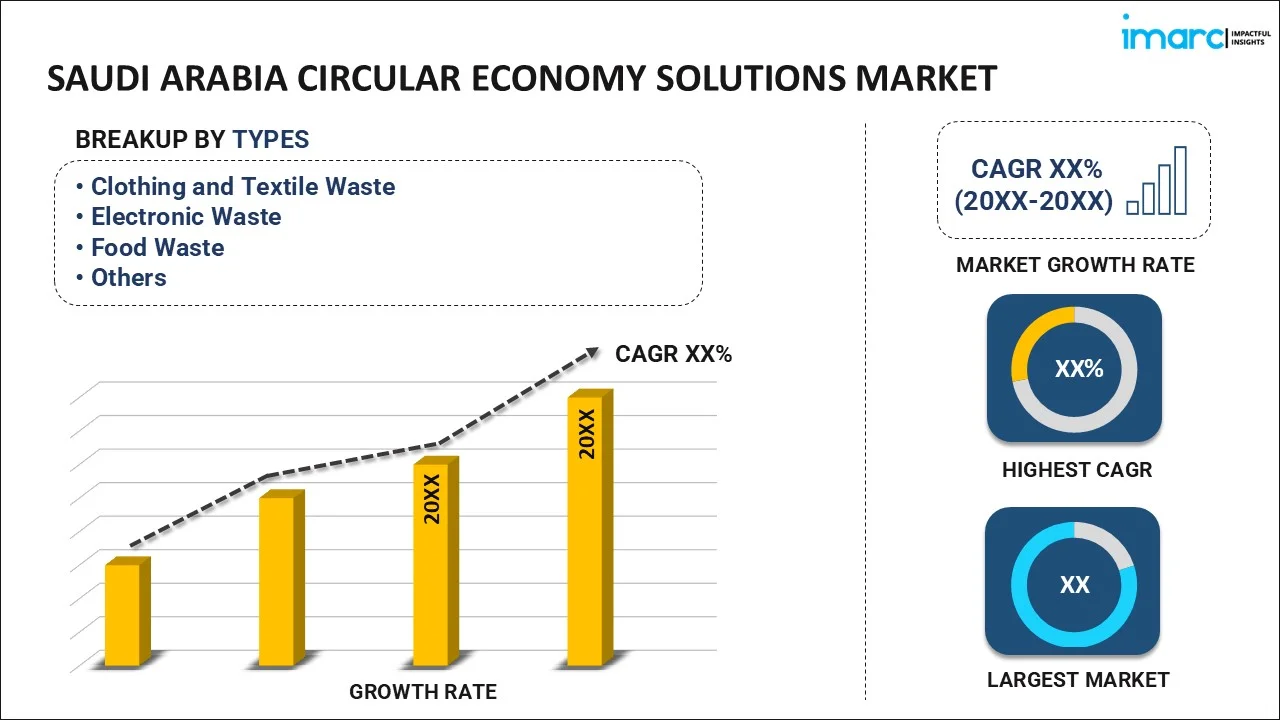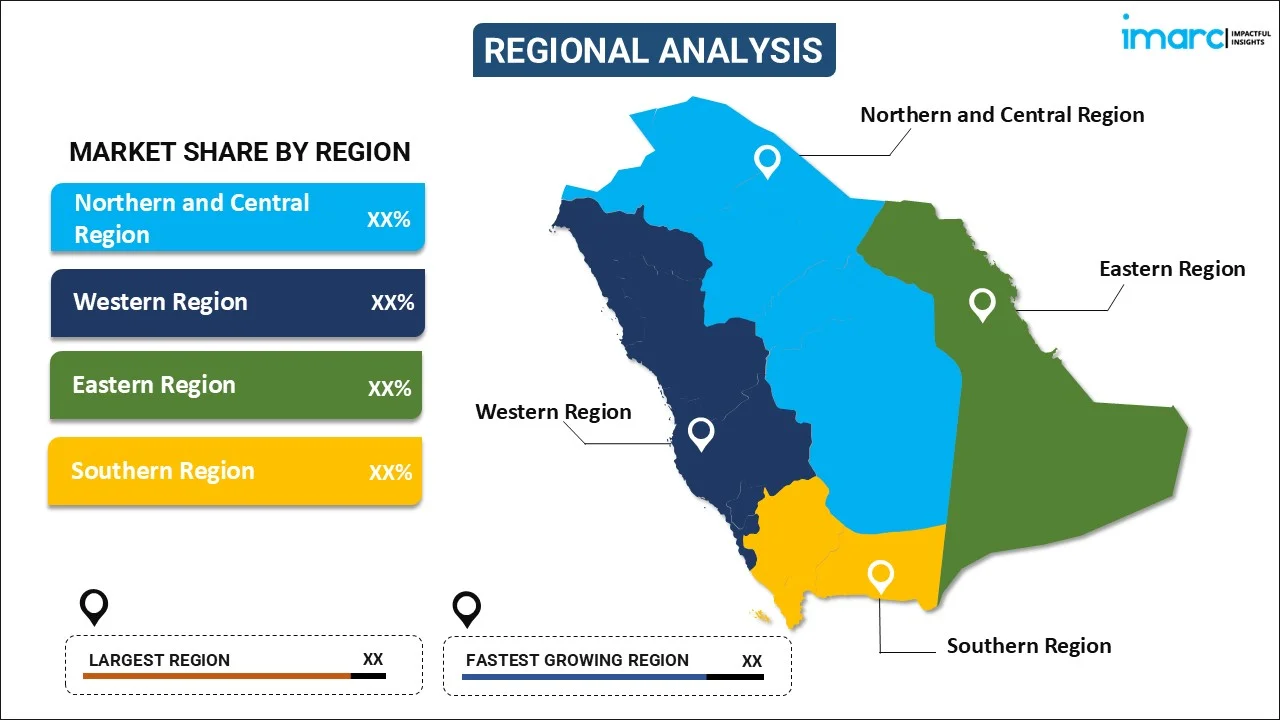
Saudi Arabia Circular Economy Solutions Market Size, Share, Trends and Forecast by Type, Enterprise Size, Industry Vertical, and Region, 2026-2034
Saudi Arabia Circular Economy Solutions Market Size and Share:
The Saudi Arabia circular economy solutions market size reached USD 6.3 Billion in 2025. Looking forward, IMARC Group expects the market to reach USD 16.8 Billion by 2034, exhibiting a growth rate (CAGR) of 11.52% during 2026-2034. The market is gaining momentum, driven by the imposition of favorable policies, rising consumer awareness about sustainability, rapid technological advancements, introduction of government-backed renewable energy investments, and the heightened focus on economic diversification.
|
Report Attribute
|
Key Statistics
|
|---|---|
|
Base Year
|
2025
|
|
Forecast Years
|
2026-2034
|
|
Historical Years
|
2020-2025
|
| Market Size in 2025 | USD 6.3 Billion |
| Market Forecast in 2034 | USD 16.8 Billion |
| Market Growth Rate (2026-2034) | 11.52% |
Access the full market insights report Request Sample
Saudi Arabia Circular Economy Solutions Market Trends:
Implementation of Government Vision and Strategic Initiatives
The Kingdom of Saudi Arabia's strategic plans, spearheaded by Vision 2030, are one of the main impetuses for circular economy solutions in the region. It focuses on diversifying the economy, minimizing reliance on oil, and enhancing sustainable approaches, placing the circular economy at the heart of national development. Additionally, government policy and regulation implementation along with focused funds are pushing the industries to implement waste reduction, resource conservation, and green product lifecycle management at the forefront, driving the growth of the market. For example, there are some national initiatives promoting recycling, waste-to-energy (WTE) schemes, and green manufacturing practices that make products last longer. Moreover, the amplified collaborations between governments and private enterprises, developing new business models in favor of circular practices, are driving the growth of the market.
Rising Consumer Awareness and Demand for Sustainable Practices
The growing consciousness among consumers to be environmentally friendly, driven by education, the influence of social media, and worldwide movements for sustainability, is making the industry look upmarket. This paradigm shift in consumers' choice is making Saudi businesses adopt circular economy principles, since consumers are pushing for products that have less harmful effects on the environment and aligning with enterprises that are inclined toward sustainability. Apart from this, the increased consciousness among the youth community regarding environmental concerns, encouraging brands to identify themselves with values by supporting green products, ethical means of procurement, and waste reduction practices, is driving the growth of the market. Furthrmore, the growing consumeristic demand that drives the supply chain and encourages organizations to innovate through circular ways is supporting the growth of the industry.
Rapid Technological Innovation and Digital Transformation
The rising technological advancements that revolutionize circular economy solutions in Saudi Arabia by making sustainable practices more feasible and efficient are acting as growth-inducing factors. Along with this, the widespread adoption of technologies like artificial intelligence (AI), the Internet of Things (IoT), and blockchain that offer better resource tracking, waste management, and recycling processes is fueling the market growth. For example, IoT sensors allow companies to monitor resource use and optimize consumption, while AI can analyze waste patterns to suggest improvements in recycling and waste reduction. According to the sources, in October 2024, AI-driven innovations are reshaping Saudi Arabia’s circular economy, enhancing waste management, recycling, and resource efficiency. Startups like Sadeem, Plastic Bank, and Naqaa Solutions integrate AI for sustainability, supporting Vision 2030. Moreover, blockchain technology enhances transparency in supply chains, allowing consumers and businesses to verify the sustainability of products and practices.
Saudi Arabia Circular Economy Solutions Market Segmentation:
IMARC Group provides an analysis of the key trends in each segment of the market, along with forecasts at the region level for 2026-2034. Our report has categorized the market based on type, enterprise size, and industry vertical.
Type Insights:

To get detailed segment analysis of this market Request Sample
- Clothing And Textile Waste
- Electronic Waste
- Food Waste
- Glass Waste
- Plastic Waste
- Wood Waste
The report has provided a detailed breakup and analysis of the market based on the type. This includes clothing and textile waste, electronic waste, food waste, glass waste, plastic waste, and wood waste.
Enterprise Size Insights:
- Large Enterprises
- Small And Medium Enterprises (SMEs)
A detailed breakup and analysis of the market based on the enterprise size have also been provided in the report. This includes large enterprises, small and medium enterprises (SMEs).
Industry Vertical Insights:
- Manufacturing Industry
- Consumer Goods
- Waste Management and Recycling
- Construction and Building Materials
- Automotive and Transportation
- Food and Agriculture
- Others
The report has provided a detailed breakup and analysis of the market based on the industry vertical. This includes manufacturing industry, consumer goods, waste management and recycling, construction and building materials, automotive and transportation, food and agriculture, and others.
Regional Insights:

To get detailed regional analysis of this market Request Sample
- Northern and Central Region
- Western Region
- Eastern Region
- Southern Region
The report has also provided a comprehensive analysis of all the major regional markets, which include Northern and Central region, Western region, Eastern region, Southern region.
Competitive Landscape:
The market research report has also provided a comprehensive analysis of the competitive landscape. Competitive analysis such as market structure, key player positioning, top winning strategies, competitive dashboard, and company evaluation quadrant has been covered in the report. Also, detailed profiles of all major companies have been provided.
Saudi Arabia Circular Economy Solutions Market News:
- In December 2023, the Saudi Investment Recycling Company (SIRC) and the Alliance to End Plastic Waste entered into a Memorandum of Understanding (MoU) to tackle plastic waste in the Kingdom of Saudi Arabia (KSA). This alliance is strategic in support of KSA's goal to realize a 94% landfill diversion by 2035 and create a strong Saudi circular economy. The purpose of this partnership is to find effective waste management practices in the nation by addressing the problems presented by municipal solid waste (MSW) and plastics in particular.
- In September 2024, Tetra Pak released its first-ever Arabia sustainability report that highlights its leader role in building a carton package recycling infrastructure and circular economy. Tetra Pak also revealed that they have invested a total of more than USD 3.6 million in the recycling infrastructure of carton packages through strategic collaborations with OPI and STP in the Kingdom of Saudi Arabia and UPM in the United Arab Emirates.
Saudi Arabia Circular Economy Solutions Market Report Coverage:
| Report Features | Details |
|---|---|
| Base Year of the Analysis | 2025 |
| Historical Period | 2020-2025 |
| Forecast Period | 2026-2034 |
| Units | Billion USD |
| Scope of the Report |
Exploration of Historical Trends and Market Outlook, Industry Catalysts and Challenges, Segment-Wise Historical and Future Market Assessment:
|
| Types Covered | Clothing and Textile Waste, Electronic Waste, Food Waste, Glass Waste, Plastic Waste, Wood Waste |
| Enterprise Sizes Covered | Large Enterprises, Small and Medium Enterprises (SMEs) |
| Industry Verticals Covered | Manufacturing Industry, Consumer Goods, Waste Management and Recycling, Construction and Building Materials, Automotive and Transportation, Food and Agriculture, Others |
| Regions Covered | Northern and Central Region, Western Region, Eastern Region, Southern Region |
| Customization Scope | 10% Free Customization |
| Post-Sale Analyst Support | 10-12 Weeks |
| Delivery Format | PDF and Excel through Email (We can also provide the editable version of the report in PPT/Word format on special request) |
Key Questions Answered in This Report:
- How has the Saudi Arabia circular economy solutions market performed so far and how will it perform in the coming years?
- What is the breakup of the Saudi Arabia circular economy solutions market on the basis of type?
- What is the breakup of the Saudi Arabia circular economy solutions market on the basis of enterprise size?
- What is the breakup of the Saudi Arabia circular economy solutions market on the basis of industry vertical?
- What is the breakup of the Saudi Arabia circular economy solutions market on the basis of region?
- What are the various stages in the value chain of the Saudi Arabia circular economy solutions market?
- What are the key driving factors and challenges in the Saudi Arabia circular economy solutions?
- What is the structure of the Saudi Arabia circular economy solutions market and who are the key players?
- What is the degree of competition in the Saudi Arabia circular economy solutions market?
Key Benefits for Stakeholders:
- IMARC’s industry report offers a comprehensive quantitative analysis of various market segments, historical and current market trends, market forecasts, and dynamics of the Saudi Arabia circular economy solutions market from 2020-2034.
- The research report provides the latest information on the market drivers, challenges, and opportunities in the Saudi Arabia circular economy solutions market.
- Porter's five forces analysis assist stakeholders in assessing the impact of new entrants, competitive rivalry, supplier power, buyer power, and the threat of substitution. It helps stakeholders to analyze the level of competition within the Saudi Arabia circular economy solutions industry and its attractiveness.
- Competitive landscape allows stakeholders to understand their competitive environment and provides an insight into the current positions of key players in the market.
Need more help?
- Speak to our experienced analysts for insights on the current market scenarios.
- Include additional segments and countries to customize the report as per your requirement.
- Gain an unparalleled competitive advantage in your domain by understanding how to utilize the report and positively impacting your operations and revenue.
- For further assistance, please connect with our analysts.
 Request Customization
Request Customization
 Speak to an Analyst
Speak to an Analyst
 Request Brochure
Request Brochure
 Inquire Before Buying
Inquire Before Buying




.webp)




.webp)












